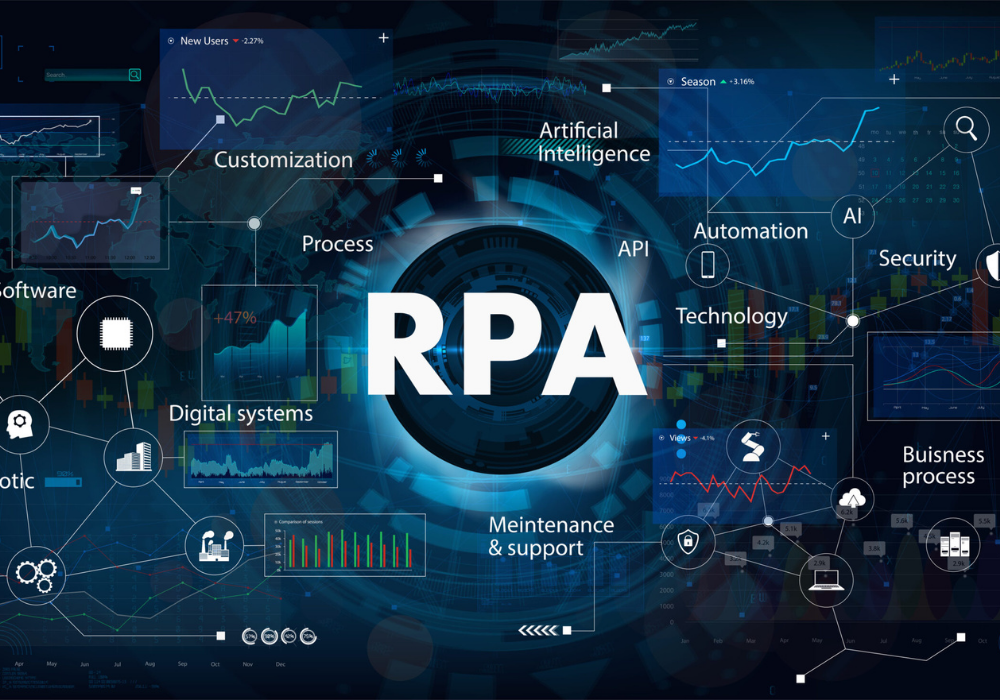Streamlined Processes, Maximised Impact: The Future of SME Automation

Streamlined Processes, Maximized Impact: The Future of SME Automation Small businesses are embracing automation at a remarkable pace, recognising its potential to transform daily operations, improve efficiency, and support sustainable growth. With solutions designed to fit the unique challenges SMEs face, the automation landscape is no longer exclusive to large corporations—it’s a key driver of innovation for businesses of all sizes. Automation, particularly Robotic Process Automation (RPA), is making waves across industries. From retail to healthcare, finance to manufacturing, the ability to automate repetitive and time-consuming tasks is proving invaluable. Curious about the industries already leveraging this technology? Take a look at how RPA can work across sectors on our Sector Page. Automation Built for SMEs Automation isn’t just about cutting-edge tech; it’s about tailored solutions that fit your business’s needs and budget. At SmartTechNXT, we offer three distinct automation models to ensure flexibility and scalability for SMEs: DIY: Full Control at Your Fingertips This “Do it Yourself” approach empowers businesses to purchase and implement automation tools on their own terms. Perfect for companies with in-house technical teams, this model includes: Flexible subscription options, available annually or monthly. Robust tools like ElectroNeek and Fortra, designed for seamless integration. If your team is tech-savvy and ready to take charge, this option offers autonomy and cost-efficiency. DiWY: A Collaborative Approach The “Do it With You” model combines expert support with client input. This tier includes: Comprehensive packages encompassing licensing, bot builds, and ongoing support. Focused project builds for specific needs. Ideal for SMEs wanting tailored automation solutions while maintaining some control, this approach bridges expertise with collaboration. DiFY: Leave It to the Experts The “Do it For You” option simplifies automation with a fully managed Robotics-as-a-Service (RaaS) model. We handle the heavy lifting, so you can focus on outcomes, not processes. With entry-level packages starting from just R4k per month, this model is perfect for businesses looking for impactful automation without technical expertise. The Transformative Potential of Automation Why is automation growing so rapidly among SMEs? It’s not just about efficiency—it’s about unlocking opportunities. Automating tasks like customer onboarding, invoicing, and data management allows small businesses to: Save valuable time for teams to focus on growth-oriented activities. Reduce manual errors and improve overall accuracy. Access affordable solutions that scale as the business expands. With scalable tools and flexible pricing models, automation is no longer a luxury—it’s an essential strategy for staying competitive in today’s fast-paced market. Whether you’re just starting your automation journey or looking to expand your capabilities, the future of SME growth is streamlined, efficient, and brimming with possibilities. To learn more about how automation can reshape your business processes, explore SmartTechNXT’s tailored solutions.
Streamlining Claims Processing with Automation in Insurance

Streamlining Claims Processing with Automation in Insurance Claims processing is a vital function in the insurance industry but often involves repetitive, time-consuming tasks. Manual workflows can slow down approvals, increase operational costs, and cause delays for customers awaiting resolution. Fortunately, automation is here to save the day, offering insurers a way to handle claims faster and more efficiently. Simplifying Data Extraction and Validation Automation tools can handle the heavy lifting of extracting information from claim forms, documents, and emails. Instead of someone manually sifting through pages of data, bots can gather the required information, cross-check it with internal systems, and flag inconsistencies. This ensures faster processing times and reduces the risk of manual errors slipping into the workflow. Efficient Claims Assessment Automation can speed up the assessment process by pre-screening claims against predefined criteria. For instance, bots can analyse policy terms, verify coverage, and identify fraudulent claims more effectively than traditional manual methods. This reduces bottlenecks in the assessment phase, allowing legitimate claims to move forward without unnecessary delays. Streamlining Communication Keeping customers informed about their claims is critical. Automation can enhance communication by sending real-time updates on claim statuses, such as when a claim is received, processed, or approved. These timely notifications not only improve customer experience but also free up team members from repetitive follow-ups. Faster Approvals and Payouts One of the biggest advantages of automation in claims processing is its ability to fast-track approvals. Once a claim is validated, bots can process the required documentation, calculate payouts, and trigger payment processes. This results in quicker settlements, improving customer satisfaction and building trust in the insurer’s services. Audit Trails Made Easy Automation doesn’t just streamline operations; it also ensures compliance with industry regulations. By maintaining detailed, automated audit trails of every step in the claims process, insurers can meet regulatory requirements more easily and with less administrative hassle. The Bottom Line for Insurers Incorporating automation into claims processing isn’t just about working faster—it’s about working smarter. By reducing manual intervention, insurers can process claims more efficiently, improve accuracy, and focus their teams on more complex, high-value tasks. For customers, this translates into quicker resolutions and better service, making automation a win-win solution for all.
Optimising Appointment Scheduling with Automation in Healthcare

Optimising Appointment Scheduling with Automation in Healthcare Appointment scheduling in healthcare can often feel like a chaotic puzzle. Between juggling patient availability, practitioner schedules, and last-minute changes, manual processes can lead to double bookings, missed slots, or long waiting times. Enter automation—the game-changer that’s making appointment scheduling smoother and stress-free for everyone involved. Real-Time Availability at Your Fingertips Gone are the days of flipping through appointment books or endless back-and-forth phone calls. Automation systems integrate with electronic health records (EHRs) and practitioner calendars to display real-time availability. Patients and staff can book slots instantly, reducing the risk of scheduling conflicts. Eliminating Manual Errors Manual errors like overlapping appointments or incorrect booking details can throw a wrench in the day’s flow. Automated systems validate data as appointments are booked, ensuring all details—like the patient’s name, reason for visit, and preferred location—are accurate and complete. Handling Cancellations and Rescheduling with Ease Cancellations are inevitable, but automation keeps them from becoming a headache. Patients can cancel or reschedule through user-friendly portals, and the system automatically frees up the slot for others. Bots can even prioritise urgent cases for the newly available times, ensuring no opportunity is wasted. Sending Friendly Reminders Missed appointments? Not anymore. Automated reminders via SMS, email, or even app notifications ensure patients remember their upcoming visits. These reminders can be tailored to include pre-appointment instructions, like fasting before a test, improving overall efficiency. Streamlining Multi-Specialist Clinics For healthcare providers with multiple practitioners or services, automation shines. It intelligently matches patients with the right specialists based on their needs and availability, ensuring patients receive the care they require without unnecessary delays. Improving Patient Experience An easy-to-navigate online scheduling system makes the process simple and convenient for patients. No more waiting on hold or navigating complicated systems—just a few clicks, and their appointment is set. Happy patients are more likely to return and recommend the service to others. Saving Time for Staff By automating appointment scheduling, administrative staff can focus on more critical tasks rather than spending hours coordinating bookings. This not only saves time but also reduces stress and improves workflow efficiency. Scaling Without Breaking a Sweat Whether a clinic is seeing a seasonal surge in patients or expanding its services, automation handles the increased demand without the need for extra staff. It’s a scalable solution that grows alongside the healthcare provider. Automation transforms appointment scheduling from a logistical nightmare into a seamless process. By improving efficiency, accuracy, and patient satisfaction, it helps healthcare providers focus on what matters most—delivering exceptional care.
How RPA is Transforming Patient Records Management in Healthcare

How RPA is Transforming Patient Records Management in Healthcare Managing patient records is no small feat. Healthcare providers deal with mountains of data daily, from admission forms to treatment histories, lab results, and discharge summaries. The sheer volume can overwhelm even the most diligent staff. Enter Robotic Process Automation (RPA)—the unsung hero transforming how patient records are managed. Eliminating Tedious Data Entry Gone are the days of manually inputting patient information into various systems. RPA tools can extract data from scanned documents, emails, or online forms and seamlessly populate it into the required fields across different systems. This reduces the time spent on repetitive tasks and ensures data is consistently accurate. Seamless Integration Across Systems Healthcare providers often use multiple platforms for managing records, billing, and scheduling. RPA acts as the bridge between these systems, transferring patient data where needed without any manual effort. The result? No more juggling between incompatible software or worrying about data silos. Enhancing Data Accuracy Manual handling of records leaves room for mistakes—typos, missing information, or mismatched data. RPA eliminates these risks by standardising how data is entered and validated. This ensures that patient records are not only accurate but also complete, which is critical for providing quality care. Speeding Up Records Access Need to pull up a patient’s medical history for a consultation? RPA can help retrieve information from vast databases in seconds, ensuring healthcare professionals have the details they need, right when they need them. This can be a lifesaver in emergencies where time is of the essence. Improving Compliance and Security With regulations like GDPR and HIPAA dictating how patient data should be handled, compliance is a top priority. RPA ensures that patient records are stored, accessed, and processed in line with these regulations. Plus, automated audit trails make it easier to track who accessed what and when, enhancing security and transparency. Focus on Patient Care Perhaps the most significant benefit of RPA in records management is the time it frees up for healthcare professionals. Instead of being bogged down with administrative tasks, they can dedicate more attention to what matters most—providing exceptional patient care. RPA is changing the game for patient records management, making it faster, more accurate, and less burdensome. For healthcare providers, it’s not just an operational improvement; it’s a step toward delivering better, more efficient care.
Fraud Detection Made Smarter: Automation in Insurance Risk Management

Fraud Detection Made Smarter: Automation in Insurance Risk Management Insurance fraud is a thorn in the side of risk management, costing the industry billions each year. From exaggerated claims to outright fabrications, spotting fraud can feel like finding a needle in a haystack. Thankfully, automation is revolutionising how insurers tackle this persistent challenge. Sifting Through Data with Speed and Precision Insurance claims often involve heaps of data from various sources—policyholder information, claim details, supporting documents, and even social media activity. Manually reviewing this information is slow and prone to manual errors. Automation tools, powered by RPA, can rapidly comb through this data, flagging anomalies that might otherwise go unnoticed. Spotting Patterns Humans Might Miss Fraud often follows specific patterns: claims submitted right after a policy starts, mismatched details in documentation, or a sudden spike in similar claims from the same area. Automation systems can analyse large datasets to detect these red flags in real time, ensuring suspicious activity is identified before payouts are made. Cross-Checking Against External Databases RPA bots excel at data matching and validation. They can cross-check claims against databases like vehicle repair estimates, healthcare costs, or even law enforcement records. This ensures claims align with realistic scenarios, reducing the likelihood of fraud slipping through. Improving Efficiency for Legitimate Claims Automation doesn’t just catch fraud—it also streamlines the process for legitimate claims. By quickly verifying details and routing straightforward cases for approval, insurers can focus their investigative resources on the claims that genuinely need attention. Keeping Fraud Tactics at Bay Fraudsters are constantly evolving their tactics, but automation systems can adapt just as quickly. Machine learning-enhanced tools continually refine their detection capabilities by learning from past fraud cases, making them smarter and more effective over time. Protecting Policyholders and Insurers Fraudulent claims drive up costs for everyone, including honest policyholders. By using automation to detect and prevent fraud, insurers can maintain fair premiums and build trust with their customers. Plus, the resources saved from reduced fraud can be reinvested into improving services. Fraud detection in insurance is no longer just about catching culprits—it’s about staying ahead of them. Automation not only makes risk management smarter but also ensures insurers can operate more efficiently and protect their customers from the ripple effects of fraud.
Leveraging Automation for Budgeting and Forecasting

Improving Cash Flow and Reducing Manual Work with Automation Cash flow is the heartbeat of any business, and managing it well often means a lot of tracking, reconciling, and reporting. But let’s be honest – managing cash flow manually is time-consuming and prone to slip-ups that can cause big headaches. That’s where automation steps in, helping finance teams maintain a smooth cash flow without the endless manual work. Speeding Up Accounts Receivable Nothing impacts cash flow quite like a slow accounts receivable process. Chasing down payments, sending out reminders, and following up on overdue invoices is time-consuming, and manual processes often mean some invoices fall through the cracks. Automating accounts receivable, though, changes the game. Automated reminders nudge clients to pay on time, payment confirmations are handled instantly, and overdue accounts can trigger alerts for the team. This means payments are in your account faster, boosting cash flow without needing to hound customers manually. Streamlining Expense Management Tracking expenses manually often means piles of receipts, missed deadlines, and manual data entry that can slow down the process. With automation, expense management is much simpler. Employees can upload receipts directly, automated workflows categorize and validate expenses, and approvals are processed faster. This ensures that reimbursements are accurate, and expenses are quickly accounted for, leaving finance teams with real-time insights into spending patterns that directly impact cash flow. Automating Invoice Processing Manual invoice processing not only eats up time, which can delay payments and disrupt cash flow. Automated invoicing streamlines this process, taking the data from purchase orders and vendor information and generating invoices with little to no manual input. An RPA system automatically checks for consistency, flags discrepancies, and sends approved invoices for payment on schedule. Not only does this improve accuracy, but it also means that invoices are processed on time, keeping cash flow steady and reducing the need for last-minute reconciliations. Enhancing Forecasting Accuracy Forecasting cash flow accurately often requires sifting through mountains of data, and that’s hard to do by hand. Automation gathers, organizes, and analyses data from across the company, giving finance teams an up-to-date view of cash flow patterns. By automating the forecasting process, businesses can spot trends, prepare for upcoming expenses, and make informed decisions about spending and investments. This ensures that cash flow planning is based on real, data-driven insights rather than guesswork. Minimizing Errors in Financial Data Manual data entry often leads to small errors that can create big cash flow problems. Automation reduces this risk by handling data entry, reconciliation, and reporting with minimal manual input. With reliable, error-free data, finance teams can be confident in the numbers they’re working with, making it easier to maintain a healthy cash flow and avoid costly mistakes that disrupt financial planning. Automation does more than just cut down on busy work; it optimizes cash flow and reduces friction in financial processes, allowing teams to focus on growth instead of paperwork. With automated invoicing, improved forecasting, faster collections, and reduced errors, businesses can take better control of their cash flow without the drag of manual processes.
Automating Regulatory Compliance in Finance

Automating Regulatory Compliance in Finance For finance teams, staying compliant with a long list of regulatory requirements is crucial but can feel overwhelming. Every transaction, report, and audit must follow regulatory guidelines can be severe. Luckily, automation has become a game-changer in helping finance departments keep on top of these regulations with far less hassle. Consistent Record-Keeping Automation ensures that every transaction is logged accurately and consistently, leaving no room for manual mistakes that can cause compliance headaches. By automating record-keeping, finance teams can track, sort, and archive records with precision, knowing that the information is accessible, accurate, and up to date. When regulations require data to be stored for certain periods or formatted in specific ways, automation keeps things in order and readily available. Real-Time Monitoring and Alerts Automated systems can monitor transactions in real-time and flag anything unusual that might indicate non-compliance. These automated alerts make it easier to catch errors or inconsistencies before they turn into bigger problems. For example, if a transaction looks suspicious or doesn’t align with compliance standards, the system can pause the transaction or alert the team to check it out. This kind of real-time monitoring helps keep everything in line, allowing the team to step in and take action before issues escalate. Efficient Audit Trails One of the biggest compliance challenges in finance is creating clear, accurate audit trails for every process. Automation streamlines this by logging every action taken, creating an accessible history for auditors. This instant visibility is invaluable during audits when clear records and transparency are key to compliance. With automation, audits can be handled much more efficiently, and there’s less scrambling to gather and verify documentation. Automated Reporting and Filing With RPA, companies can set up systems that automatically handle regular compliance reporting and filing. This not only ensures accuracy but also saves time by reducing manual data entry and preparation. Whether it’s generating financial statements or filing specific compliance forms, automated reporting keeps the process timely and accurate, meaning compliance deadlines are less stressful and reporting requirements are always met. Enhanced Data Security Meeting regulatory requirements in finance often means maintaining strict data security standards. Automated compliance systems help by enforcing secure access controls, encrypting sensitive information, and ensuring that data handling complies with standards like GDPR. Automation also reduces the chance of manual errors leading to security breaches, keeping data safer and compliance simpler. By taking the pressure off finance teams, automation allows them to manage compliance in a more reliable, efficient, and stress-free way. Accurate records, real-time alerts, audit-ready trails, and enhanced security all combine to create a robust compliance environment that can keep up with the fast-evolving regulatory landscape in finance.
How Automation Reduces Errors and Saves Time

How Automation Reduces Errors and Saves Time Finance teams often juggle numbers, deadlines, and a boatload of regulations that can make anyone’s head spin. With so many things to balance, it’s easy for tiny errors to creep in. And in finance, even the smallest slip-up can cause big headaches! Enter automation—a streamlined way to handle the tedious, error-prone stuff so humans can focus on the more meaningful work (and maybe enjoy a bit of breathing room, too). Real-Time Reporting for Quick Decisions With bots gathering data on a continual basis, automated systems can offer real-time reporting. Imagine being able to make an important business decision based on current data instead of waiting for the end-of-quarter reports. Automation gives finance teams the tools to make quicker, smarter decisions based on live information, without the bottlenecks of manual data processing. Saying Goodbye to Manual Errors Automating financial reporting means setting up bots to do all the repetitive, detailed tasks, such as data entry and transaction validation. These bots follow a set of rules, pulling info from various systems, checking for any discrepancies, and ensuring the numbers always add up. Because they’re programmed to operate with a high degree of precision, they avoid the small mistakes that can occur manually like typing an extra zero or misplacing a decimal point. Fewer errors mean less rework and a whole lot less stress when it comes to finalizing financial reports. Speeding Up Processes Without Losing Accuracy Let’s face it—reporting cycles can be painfully long, especially when everyone’s checking and double-checking for mistakes. Automation speeds things up by handling these processes in the blink of an eye. Bots can pull data, run calculations, and generate reports in minutes, not hours or days. That extra time saved means finance teams can focus on deeper insights or planning the next steps rather than endlessly cross-checking spreadsheets. Boosting Compliance with Less Hassle In finance, compliance is king. Automated systems are set up to keep everything in line with regulatory requirements. That means not only are records accurate, but they’re also automatically organised for audits. Having automated, accurate, and ready-to-go records is like an accountant’s dream come true—and it saves everyone a lot of panic during audit season. By taking on repetitive, error-prone tasks, automation allows finance teams to get more done, more accurately, and without the hassle. With fewer errors, faster reporting, and easy compliance, the whole department becomes a well-oiled machine—and that’s something everyone can appreciate!
Improving Payroll Accuracy and Compliance Through RPA

Improving Payroll Accuracy and Compliance Through RPA Let’s face it: payroll is one area where there’s zero room for error. Missteps can lead to some seriously unhappy employees and potential compliance headaches. RPA (Robotic Process Automation) steps in as the ultimate payroll assistant, working quietly behind the scenes to ensure everything from tax withholdings to deductions and overtime calculations is spot on, every single time. Accurate Payments, Every Paycheck Instead of relying on manual data entry (and all the errors that can creep in), automated bots handle payroll data with precision. They pull info directly from attendance systems, employee records, and tax tables, leaving HR teams with confidence that each paycheck is calculated accurately. Bots are tireless—so whether it’s end-of-month crunch or last-minute changes, they keep payroll accurate and on track. Tax Compliance and Timely Filing Tax laws can be complex and ever-changing, and keeping up with them can feel like a full-time job. RPA makes sure payroll processes align with the latest tax regulations by automatically updating rates and checking calculations. For companies with employees across different states or countries, bots can handle multiple tax codes and compliance rules, easing the administrative burden of cross-border payroll. Efficient Reporting and Record-Keeping RPA doesn’t just pay people—it’s also a superstar for record-keeping and reporting. From generating payroll reports to tracking historical data, automated systems make it easy to access accurate payroll information when needed. Audits become far less stressful, as every transaction is meticulously logged and easily traceable. Employee Satisfaction with On-Time, Error-Free Payments At the end of the day, employees want to be paid accurately and on time. Automated payroll ensures there are no surprises, which helps build trust and keeps morale high. Employees can check their statements knowing the numbers add up, and HR can rest easy knowing everyone’s been paid right.
Employee Onboarding and Offboarding with RPA

Employee Onboarding and Offboarding with RPA Employee onboarding is a busy time for HR, and RPA makes it smoother by handling the admin-heavy tasks with accuracy and speed. When a new hire joins, automated bots can send out the welcome email, set up their system access, update HR systems with their details, and even order equipment like laptops and ID badges. All these processes, which might normally involve a bunch of back-and-forth emails and data entry, happen seamlessly with RPA—so new hires are set up and ready from day one. Document Collection and Compliance Collecting and verifying documents, like IDs and signed contracts, is a key part of onboarding. RPA can help by sending reminders to new hires for any missing paperwork and tracking everything to make sure no forms slip through the cracks. Bots can also automatically upload files to the appropriate systems, keeping the HR team’s workflow clean and reducing the risk of misplacing essential documents. Training and Orientation Schedules RPA can take care of assigning training modules, setting up orientation sessions, and sending reminders for any required certifications. This automation ensures that every new employee receives the correct training and certifications, aligned with company policy. Instead of juggling multiple calendars and spreadsheets, HR can trust that new hires will be guided through their first weeks smoothly and consistently. Efficient Offboarding for Exiting Employees Offboarding involves multiple steps, like revoking system access, collecting company assets, and managing final payments. RPA bots handle all this automatically, so when an employee leaves, there’s no delay in deactivating accounts, stopping benefits, or processing their final paycheck. It helps avoid any security issues and ensures that each step is completed on time, without taking up HR’s day. Consistent Experience for Every Employee With RPA, the onboarding and offboarding experiences become consistent for every employee. No more worrying about steps getting skipped or delays in the process; bots follow the same protocol every time. This consistency not only makes things easier for HR but also leaves employees feeling valued and well-managed during these big transitions.